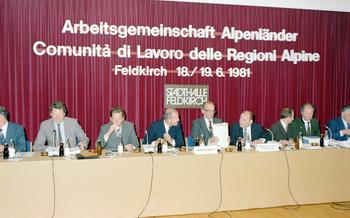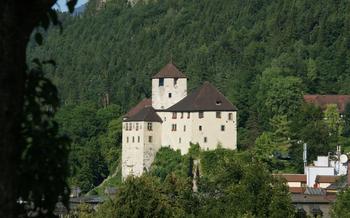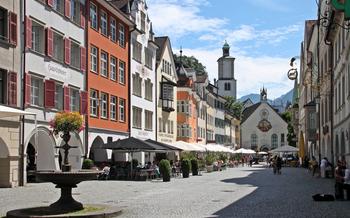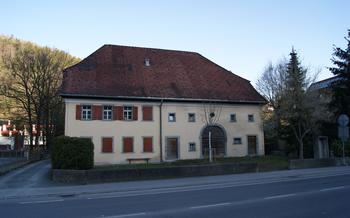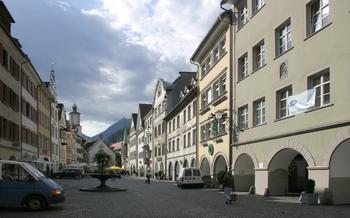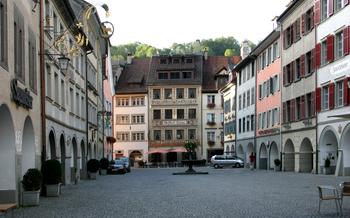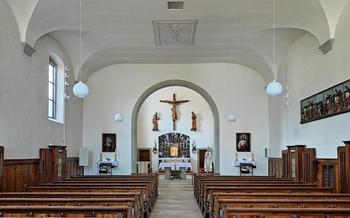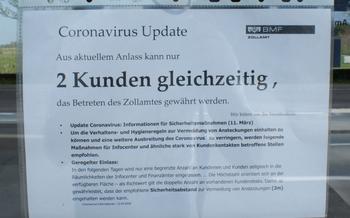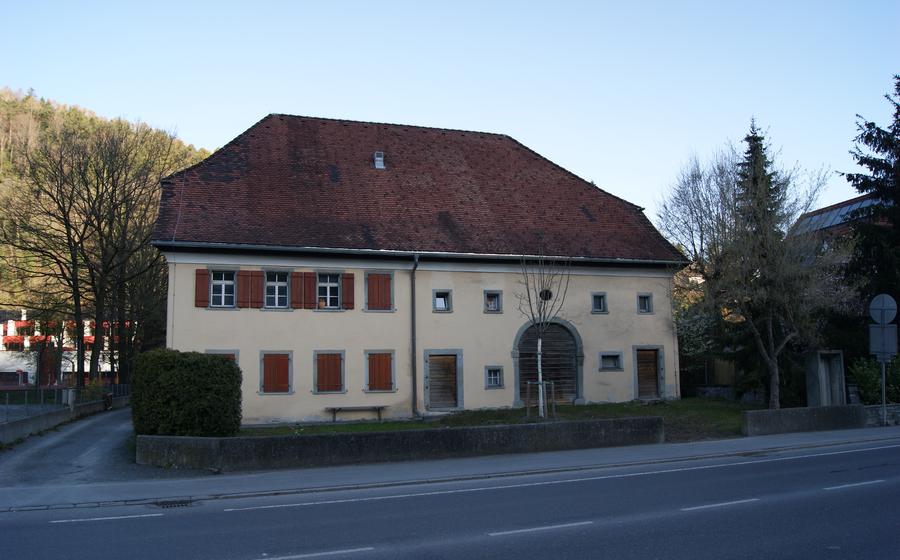
Feldkircher Pilgrimage Church
- Exploring the Church's Interior
- Pilgrimage Route and Stations of the Cross
- The Legendary Miracle of the Bleeding Host
- Feldkirch's Rich History and Heritage
- St. Nikolaus Cathedral: A Gothic Masterpiece
- Exploring the Old Town of Feldkirch
- Schattenburg Castle: A Majestic Fortress
- The Montfort House: A Cultural Gem
- Feldkirch's Vibrant Cultural Scene
- Hiking and Outdoor Adventures
- Day Trips from Feldkirch
- Practical Information for Visitors
- Insider Tip: The Secret Garden of the Montfort House
Exploring the Church's Interior
Step inside the Feldkircher Pilgrimage Church, and you'll be greeted by a breathtaking spectacle of art and devotion. The walls and ceilings are adorned with exquisite frescoes and paintings, depicting biblical scenes and the life of Christ. The intricate carvings and sculptures, crafted with meticulous precision, add depth and texture to the sacred space.
The high altar stands as a majestic centerpiece, a testament to the artistry and craftsmanship of its creators. Its intricate design, featuring a multitude of figures and symbols, invites contemplation and reverence. The stained glass windows, with their vibrant colors and evocative imagery, cast a warm and ethereal glow upon the interior, creating an atmosphere of tranquility and awe.
Each element of the church's interior has been carefully conceived to inspire devotion and provide a sanctuary for spiritual reflection. The frescoes, painted in the Baroque style, depict scenes from the life of Jesus, the Virgin Mary, and the saints. They serve as visual aids, helping the faithful to connect with the divine through the power of art.
The carvings and sculptures, often depicting angels, saints, and biblical figures, add a sense of depth and dimension to the church's interior. They seem to come alive, inviting visitors to engage with the stories they represent. The stained glass windows, with their intricate stained glass panels, allow natural light to filter into the church, creating a kaleidoscope of colors that dance upon the walls and floor.
Together, these artistic elements create a harmonious and uplifting environment, conducive to prayer and contemplation. The Feldkircher Pilgrimage Church stands as a testament to the power of faith and the enduring legacy of artistic expression.
Pilgrimage Route and Stations of the Cross
Pilgrimage to the Feldkircher Pilgrimage Church holds a deep significance for many believers. Devotees embark on a spiritual journey along a designated pilgrimage route, beginning at the city gates and leading to the church. The route is marked by Stations of the Cross, each depicting a scene from Jesus' crucifixion and resurrection. These intricate and moving artworks serve as a reminder of Christ's suffering and sacrifice.
As pilgrims progress along the route, they stop at each station to pray, reflect, and contemplate the events of Jesus' passion. This meditative practice allows them to connect with the story of salvation and deepen their faith. The Stations of the Cross not only enhance the pilgrimage experience but also provide a profound spiritual dimension to the journey.
For those seeking a truly immersive and transformative experience, the pilgrimage to the Feldkircher Pilgrimage Church offers a unique opportunity to walk in the footsteps of countless believers who have come before them. The spiritual journey, coupled with the stunning scenery and serene atmosphere, creates a lasting impression that will stay with pilgrims long after their visit.
The Legendary Miracle of the Bleeding Host
The Feldkircher Pilgrimage Church is steeped in legend and mystery, with the most prominent tale being the miracle of the bleeding host. According to legend, in the 14th century, a priest was celebrating mass when he accidentally dropped the consecrated host on the ground. To his shock and horror, the host began to bleed profusely. This extraordinary event was seen as a sign from God, and the bleeding host became a sacred relic.
The Eucharistic miracle of the bleeding host played a pivotal role in the history of the church. It attracted pilgrims from far and wide, who came to witness the miraculous host and seek divine intervention. The church became a renowned pilgrimage site, and its reputation as a place of miracles grew throughout the centuries.
The monstrance, a specially designed reliquary, was created to house the bleeding host. It is a masterpiece of craftsmanship, adorned with intricate carvings and precious stones. The monstrance is displayed prominently in the church, allowing visitors to view the relic and reflect on the significance of the miracle.
The miracle of the bleeding host continues to be a source of fascination and devotion for pilgrims and visitors alike. It serves as a reminder of the profound spiritual and religious significance of the Feldkircher Pilgrimage Church.
Feldkirch's Rich History and Heritage
Feldkirch, nestled in the heart of Western Austria, boasts a rich history and heritage that dates back to the Middle Ages. Its strategic location at the crossroads of important trade routes made it a thriving center of commerce and culture. During the reign of the Habsburg dynasty, Feldkirch flourished as a vital administrative and economic hub.
The town's medieval origins are still evident in its well-preserved Old Town, where cobblestone streets wind past historic buildings, charming cafes, and boutiques. Notable landmarks include the Schattenburg Castle, a formidable fortress that once guarded the town, and the St. Nikolaus Cathedral, a stunning example of Gothic architecture.
Feldkirch's diverse heritage is a blend of Germanic, Romanesque, and Alemannic influences, resulting in a unique cultural landscape. The town's many historical sites, museums, and festivals celebrate this rich tapestry of traditions, offering visitors a glimpse into Feldkirch's fascinating past.
St. Nikolaus Cathedral: A Gothic Masterpiece
Standing tall amidst the historic heart of Feldkirch, St. Nikolaus Cathedral is a testament to the town's rich past and architectural prowess. Its Gothic grandeur captivates visitors with its intricate details and soaring spires, making it a symbol of both religious devotion and artistic excellence.
Built in the 15th century, the cathedral showcases the transition from Romanesque to Gothic styles, with its ribbed vaults, pointed arches, and ornate tracery. The interior is adorned with stunning frescoes, intricate carvings, and stained glass windows that depict biblical scenes and the lives of saints. The most striking feature is the elaborate high altar, a masterpiece of Gothic craftsmanship with its intricate carvings and gold leaf embellishments.
The cathedral holds a special significance in the history of Feldkirch, serving as a spiritual center for the town's Catholic community. It has witnessed countless religious ceremonies, celebrations, and moments of contemplation over the centuries, solidifying its role as a cornerstone of the town's identity.
St. Nikolaus Cathedral is not only a place of worship but also a repository of cultural and historical treasures. Its walls hold stories of the town's past, the struggles and triumphs of its people, and the enduring spirit of faith that has shaped Feldkirch's destiny.
Exploring the Old Town of Feldkirch
Step into the heart of Feldkirch and discover its charming old town, a treasure trove of medieval history and architectural wonders. A stroll through the cobblestone streets takes you back in time, as you admire the well-preserved buildings that line the narrow lanes. Admire the intricate facades, colorful oriels, and wrought-iron signage that adorn the houses, each telling a story of the town's rich past.
Visit the Town Hall, a magnificent Renaissance building that houses the city's administration and is adorned with beautiful frescoes. Don't miss the Schattenburg Gate, the sole surviving gate of the medieval city fortifications, which offers a glimpse into Feldkirch's defensive past.
Explore the Old Market Square, the town's former center of trade, where you can browse local markets, shop for souvenirs, and savor delicious regional cuisine at one of the many cafes and restaurants.
Immerse yourself in the town's vibrant atmosphere as you wander through its charming streets, discovering hidden courtyards, historic fountains, and small boutiques. Feldkirch's old town is a living testament to its rich history, offering a blend of architectural styles and cultural influences that make it a captivating destination for visitors.
Schattenburg Castle: A Majestic Fortress
Perched majestically atop a hill overlooking the town of Feldkirch, Schattenburg Castle stands as a testament to the region's rich history and architectural prowess. The castle's origins date back to the 12th century, when it was constructed as a defensive stronghold against invading forces. Over the centuries, it underwent several expansions and renovations, reflecting the changing needs and tastes of its successive owners.
The castle's imposing presence is characterized by its thick walls, sturdy towers, and intricate fortifications. Visitors can explore the castle's many chambers and halls, which showcase a fascinating blend of medieval and Renaissance architectural styles. The castle's interior features a collection of historical artifacts, weaponry, and artwork that provide a glimpse into the lives of its former inhabitants.
One of the highlights of Schattenburg Castle is its stunning views of the surrounding landscape. From the castle's terraces and ramparts, visitors can enjoy panoramic vistas of the town of Feldkirch, the rolling hills of Vorarlberg, and the distant peaks of the Alps. The castle's unique vantage point makes it an ideal spot for photography enthusiasts and nature lovers alike.
Today, Schattenburg Castle houses a museum that delves into the history of the castle and the region. The museum's exhibits showcase the castle's role in medieval warfare, its transformation into a Renaissance palace, and its eventual conversion into a museum. Visitors can learn about the castle's former occupants, including the powerful Montfort family, and the significant events that unfolded within its walls.
Schattenburg Castle is a must-visit attraction for anyone interested in history, architecture, or stunning views. Its well-preserved state and intriguing history offer visitors a glimpse into a bygone era, while its panoramic vistas provide a breathtaking backdrop for a memorable visit.
The Montfort House: A Cultural Gem
In the heart of Feldkirch's Old Town, nestled amidst the cobblestone streets and historical buildings, stands the Montfort House, a cultural gem that offers a glimpse into the town's rich history and artistic heritage. Built in the 16th century, this magnificent Renaissance palace served as the residence of the Montfort family, the former rulers of Feldkirch. Today, it has been transformed into a vibrant cultural center, hosting a variety of exhibitions, events, and performances that celebrate the town's cultural diversity.
The Montfort House boasts an impressive architectural style that blends Renaissance and Gothic elements. Its ornate facade, adorned with intricate carvings and sculptures, reflects the artistic prowess of its time. Inside, visitors are greeted by a grand staircase that leads to a series of beautifully appointed rooms, each with its own unique character and charm. The house's well-preserved interiors offer a glimpse into the opulent lifestyle of the Montfort family and the cultural influences that shaped Feldkirch during their reign.
The Montfort House is not only a historical landmark but also a thriving cultural hub. It hosts a diverse range of exhibitions throughout the year, showcasing the works of local, national, and international artists. From contemporary art installations to historical artifacts, the exhibitions offer visitors a chance to engage with the region's vibrant cultural scene and gain insights into its artistic heritage.
The Montfort House also serves as a venue for concerts, theater performances, and literary events. Its intimate atmosphere and excellent acoustics make it an ideal setting for cultural performances and gatherings. Visitors can enjoy a variety of events, from classical music recitals to contemporary dance performances, all within the walls of this historic palace.
The Montfort House's connection to the Feldkircher Pilgrimage Church adds another layer of significance to this cultural gem. The church's treasury is housed within the Montfort House, where visitors can view the precious artifacts and relics associated with the pilgrimage, including the monstrance that holds the Eucharistic miracle. This connection further highlights the intertwined history of religion and culture in Feldkirch, making the Montfort House a must-visit destination for anyone interested in exploring the town's rich heritage.
Feldkirch's Vibrant Cultural Scene
Feldkirch is not just a town of historical significance; it also boasts a vibrant and diverse cultural scene. The town's rich cultural heritage is reflected in its many theaters, concert halls, and galleries.
Throughout the year, Feldkirch hosts a variety of cultural events, including theater performances, concerts, art exhibitions, and festivals. These events showcase local and international talent, providing visitors with a chance to experience the town's cultural diversity.
One of the highlights of Feldkirch's cultural scene is the Montfort Festival, a renowned theater festival that takes place every summer. This festival attracts renowned theater companies from around the world, showcasing a variety of plays and performances.
For art enthusiasts, Feldkirch offers a number of galleries and museums, including the Feldkirch Museum and the Schattenburg Castle Museum. These institutions house a diverse collection of art and artifacts, providing visitors with a glimpse into the town's rich history and cultural heritage.
Whether you're a theater buff, a music lover, or an art aficionado, Feldkirch's vibrant cultural scene has something to offer everyone. Be sure to check out the town's cultural events calendar to see what's on during your visit.
Hiking and Outdoor Adventures
Feldkirch is surrounded by breathtaking natural beauty, making it a haven for outdoor enthusiasts. Lace up your hiking boots and explore the scenic trails that wind through lush forests, past cascading waterfalls, and up to panoramic viewpoints. There are routes suitable for all levels, from leisurely walks along the Ill River to challenging ascents to the peaks of the Rätikon Mountains.
For those who prefer two wheels, Feldkirch offers a network of well-maintained biking trails. Take a leisurely ride along the Rhine Valley or embark on a more adventurous mountain biking excursion in the nearby mountains. E-bikes are also available for rent, making it easier to conquer those challenging inclines.
Feldkirch is also a great base for other outdoor activities. Go for a refreshing swim in Lake Constance, try your hand at stand-up paddleboarding or kayaking on the Ill River, or soar through the air on a paragliding adventure. In winter, the region transforms into a snowy wonderland, offering opportunities for skiing, snowboarding, cross-country skiing, and snowshoeing.
Day Trips from Feldkirch
Feldkirch's central location makes it an ideal base for exploring the surrounding region. Take advantage of the opportunity to venture beyond the town and discover nearby attractions and destinations.
Liechtenstein and the Rhine Valley: A short drive from Feldkirch, the tiny principality of Liechtenstein offers a glimpse into a different culture. Visit the capital, Vaduz, and explore its charming streets and landmarks. The Rhine Valley, with its picturesque villages, vineyards, and medieval castles, is a must-see for nature and history enthusiasts.
The Swiss Alps and Lake Constance: For breathtaking mountain scenery, head to the Swiss Alps. St. Gallen, with its stunning Baroque abbey, is a popular destination. Lake Constance, with its crystal-clear waters and picturesque towns, offers a variety of water sports and lakeside activities.
Other day trip options from Feldkirch: If you have more time, consider venturing further afield. Innsbruck, with its stunning mountain backdrop and rich history, is a popular choice. Salzburg, the birthplace of Mozart, offers a wealth of cultural attractions. Munich, the capital of Bavaria, is a vibrant city with a rich history and world-class museums.
Whether you prefer exploring historical towns, admiring natural wonders, or indulging in cultural experiences, Feldkirch provides a gateway to a diverse range of destinations. Plan a day trip or two to make the most of your time in this charming Austrian town.
Practical Information for Visitors
Feldkirch is easily accessible by train, bus, or car. The train station is located a short walk from the city center, and there are regular bus connections to nearby towns and villages. If you're driving, Feldkirch is situated at the intersection of several major highways, making it convenient to reach from various directions.
Accommodation options in Feldkirch range from budget-friendly hostels to luxurious hotels. There are also several guesthouses and apartments available, offering a more local experience.
When it comes to dining, Feldkirch has a diverse culinary scene. From traditional Austrian cuisine to international flavors, there's something to suit every palate. Be sure to try local specialties such as Kässpätzle (cheese noodles), Vorarlberger Käsknöpfle (cheese dumplings), and Riebel (cornmeal dish).
For tourist information, head to the Feldkirch Tourist Information Center located in the heart of the city. The friendly and knowledgeable staff can provide you with maps, brochures, and recommendations to help you make the most of your visit.
Remember to pack comfortable shoes as Feldkirch is best explored on foot. The cobblestone streets and narrow alleys are a delight to wander through, and you'll discover hidden gems and charming corners around every turn.
Insider Tip: The Secret Garden of the Montfort House
Amidst the bustling streets of Feldkirch, the Montfort House holds a hidden gem—a secret garden that offers a tranquil oasis away from the urban hustle. This enchanting sanctuary is a testament to the town's rich history and its deep connection to nature.
Concealed behind the house's walls, the secret garden invites visitors to step into a world of tranquility and beauty. Lush greenery, vibrant flowers, and the gentle sound of a fountain create a serene atmosphere that soothes the soul. The garden's design pays homage to the Renaissance period, with symmetrical pathways, manicured hedges, and intricate topiaries.
Visitors can wander through the garden's meandering paths, discovering hidden nooks and secluded corners perfect for contemplation and relaxation. The air is filled with the sweet fragrance of roses, lavender, and jasmine, creating a sensory experience that transports visitors to a bygone era.
To access the secret garden, visitors should inquire at the Montfort House reception. The garden is open to the public during the warmer months and offers a unique glimpse into Feldkirch's rich cultural heritage. Whether you seek a moment of solitude, inspiration, or simply a chance to connect with nature, the secret garden of the Montfort House is a hidden treasure waiting to be explored.
